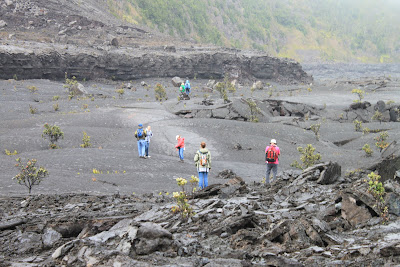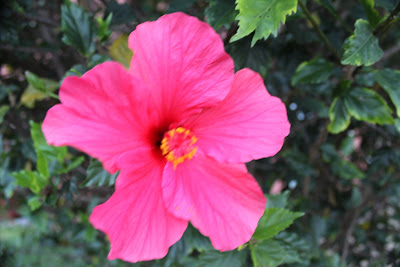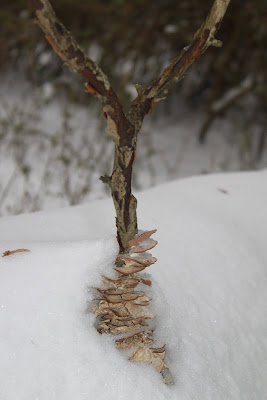 Aloha from Maui, once again! The Project ISLE group took an inter-island flight one island over on Tuesday, and we are enjoying a much needed break from the cold weather that comes with high altitudes. Before we left, however, we took a trip up the world's tallest mountain. Mount Everest is the highest mountain with the greatest elevation, but it sits on a thick continental plate. Mauna Kea is considered the world's tallest mountain when measured from the base, which is at the bottom of the ocean. Anyway, there are plants and animals up here that are found no where else in the world. Like the above Silversword. This iridescent silver plant blooms once every 50 years and is on the endangered species list (yes, plants can be on there too!!) I took this picture near the visitor's center, which is at 9,000 feet.
Aloha from Maui, once again! The Project ISLE group took an inter-island flight one island over on Tuesday, and we are enjoying a much needed break from the cold weather that comes with high altitudes. Before we left, however, we took a trip up the world's tallest mountain. Mount Everest is the highest mountain with the greatest elevation, but it sits on a thick continental plate. Mauna Kea is considered the world's tallest mountain when measured from the base, which is at the bottom of the ocean. Anyway, there are plants and animals up here that are found no where else in the world. Like the above Silversword. This iridescent silver plant blooms once every 50 years and is on the endangered species list (yes, plants can be on there too!!) I took this picture near the visitor's center, which is at 9,000 feet. While at the visitor's center, I saw a big looming cloud in the distance and thought I heard thunder. When I asked about it, several people thought it was just the trucks on the road up the mountain. Well, come to find out, it was thunder snow! Mauna Kea is Hawaiian for "white mountain" and it snows up here several times a year. We were lucky enough to be there on a day when it snowed in JUNE (pretty rare)! Here's the view out of the windshield of our four wheel drive van ascending to 14,000 feet.
While at the visitor's center, I saw a big looming cloud in the distance and thought I heard thunder. When I asked about it, several people thought it was just the trucks on the road up the mountain. Well, come to find out, it was thunder snow! Mauna Kea is Hawaiian for "white mountain" and it snows up here several times a year. We were lucky enough to be there on a day when it snowed in JUNE (pretty rare)! Here's the view out of the windshield of our four wheel drive van ascending to 14,000 feet. They do some intense astronomical research up there. WAY over my head.
They do some intense astronomical research up there. WAY over my head. This is the Subaru Telescope, which has nothing to do with the car company. This telescope is funded completely by the Japanese and costs about $100,000 a day to run. The main mirror of this telescope weighs 22 tons, took 3 years to make, and an additional 4 years to polish. It takes an entire month to clean it, which they do every 3-4 years. I think they said the mirror was 30 feet across. I guess I don't know very much about astronomy because my naive brain pictured a HUGE telescope with a little eyepiece somewhere at the bottom of it. These fancy telescopes are controlled entirely by computers and most of the scientists using them aren't even in the building when they use it!
This is the Subaru Telescope, which has nothing to do with the car company. This telescope is funded completely by the Japanese and costs about $100,000 a day to run. The main mirror of this telescope weighs 22 tons, took 3 years to make, and an additional 4 years to polish. It takes an entire month to clean it, which they do every 3-4 years. I think they said the mirror was 30 feet across. I guess I don't know very much about astronomy because my naive brain pictured a HUGE telescope with a little eyepiece somewhere at the bottom of it. These fancy telescopes are controlled entirely by computers and most of the scientists using them aren't even in the building when they use it!  A small group of us braved the thin air and hiked out to one of the world's only permafrost fed lakes. This altitude has only about half the oxygen that sea level has, so we were huffing and puffing the whole way here.
A small group of us braved the thin air and hiked out to one of the world's only permafrost fed lakes. This altitude has only about half the oxygen that sea level has, so we were huffing and puffing the whole way here. Back down at the visitor's center, Steve O'Meara (world renowned volcanologist and astronomer) showed us a few things with his own telescope. It was really dark, so I played around with my camera settings :)
Back down at the visitor's center, Steve O'Meara (world renowned volcanologist and astronomer) showed us a few things with his own telescope. It was really dark, so I played around with my camera settings :) Mike, one of the ISLE participants was nice enough to stand still for a really long time so I could get this cool shot.
Mike, one of the ISLE participants was nice enough to stand still for a really long time so I could get this cool shot.  Now to Maui. Yesterday was our first full day, and we traveled around hearing various speakers. Here are two ISLE participants at the Maui Humpback Whale Marine Sanctuary with their newest creations. The education specialists at the sanctuary gave our teachers a bunch of great ideas to take back to their classrooms!
Now to Maui. Yesterday was our first full day, and we traveled around hearing various speakers. Here are two ISLE participants at the Maui Humpback Whale Marine Sanctuary with their newest creations. The education specialists at the sanctuary gave our teachers a bunch of great ideas to take back to their classrooms! This morning's sunrise. Camp Olowalu is right on the beach, and our little A-frame cabins have screen windows only. I listen to the waves crashing on the beach all night and wake up to birds chirping in the morning. So peaceful.
This morning's sunrise. Camp Olowalu is right on the beach, and our little A-frame cabins have screen windows only. I listen to the waves crashing on the beach all night and wake up to birds chirping in the morning. So peaceful. Here we are at another telescope on top of another volcano (Haleakala). However, this telescope focuses on learning about the sun. It's the biggest solar telescope in the world. There are several other telescopes at the top of Haleakala including one that has the largest (published) camera with 1.3 giga pixels and another Air Force telescope that specializes in detecting attack satellites. Apparently there are people out there (terrorists?) who may not be able to shoot their own billion dollar satellite into space, but can shoot up another small one with missiles designed to blow up another country's billion dollar satellite and cause a major disruption in communication. Interesting stuff.
Here we are at another telescope on top of another volcano (Haleakala). However, this telescope focuses on learning about the sun. It's the biggest solar telescope in the world. There are several other telescopes at the top of Haleakala including one that has the largest (published) camera with 1.3 giga pixels and another Air Force telescope that specializes in detecting attack satellites. Apparently there are people out there (terrorists?) who may not be able to shoot their own billion dollar satellite into space, but can shoot up another small one with missiles designed to blow up another country's billion dollar satellite and cause a major disruption in communication. Interesting stuff.
Here we are down at the Haleakala visitor's center. It was SO WINDY, but we had a lot of fun. The next several days here on Maui will focus on snorkeling, island ecology, and marine issues. My underwater camera is 35mm, so it'll be a while until I can post those pictures. Should be fun!

























